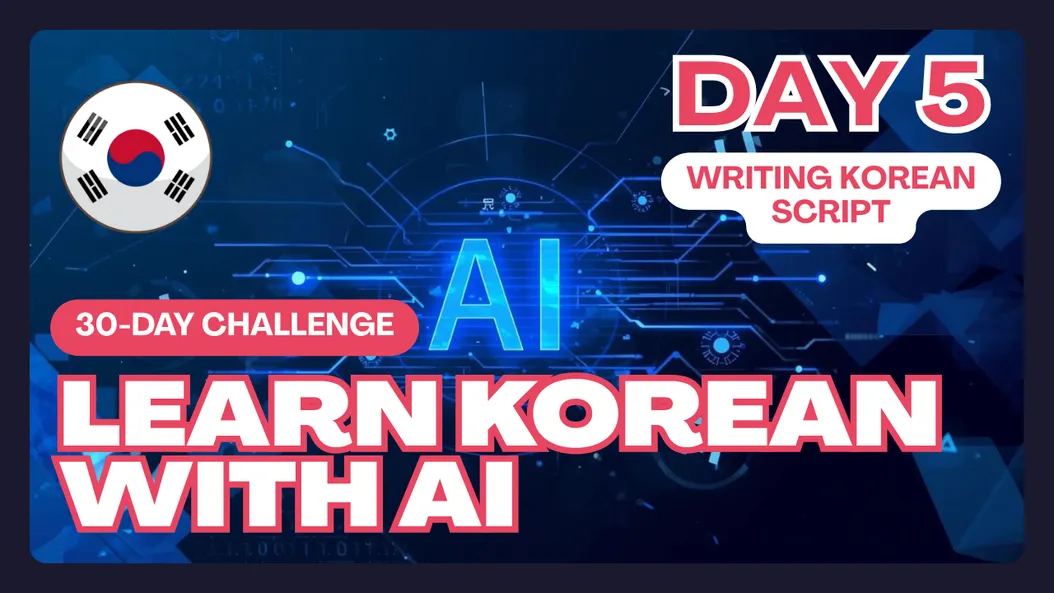Video
Text
Hey everyone. It’s Keith Hayden, the Digital Novelist, checking in with Day Five of my AI only Korean learning experiment.
If you’re new here, I’m spending 30 days learning Korean entirely through AI tools to see what language acquisition actually looks like in the age of AI. No textbooks. No apps. No teachers. Just the machines.
If you want to catch up on previous days, the playlist and links are here. (And yes, the link actually works today!) Tower of Babbling 2.0 is where I am chronicling the full journey.
Today was a big milestone. It was my first day writing Korean.
Starting Early Changes Everything
I hit Korean first thing this morning instead of waiting until the end of the day when I am exhausted. I opened ChatGPT and asked, “What should I do for Day 5?” The answer came back quickly. Writing practice.
Which meant I needed to install Korean typing on my computer.
That alone ate up about ten minutes of my session. My keyboard is a Japanese keyboard I bought in a second hand shop in Okinawa for 1000 yen (~$9 USD). The keys have English letters and hiragana printed on them. Now I am typing in Korean on top of all that.
I had three language layers competing for my attention.
Meanwhile I was telling my brain to ignore the English, ignore the Japanese, and focus only on the Korean letters.
It felt like a whole boss fight.
Why Gemini Owned Today’s Session
Once everything was installed, I switched to Google Gemini. Today reminded me why Gemini feels built for language learning.
It's strong at pronunciation support.
It's clear and intuitive with grammar scaffolding.
And today it did something I've never seen an AI do before.
It showed me a full legend for my exact keyboard layout.
Each key.
Each Korean character.
Mapped perfectly.
This might sound small, but trust me. It's massive. Without that map, writing Korean on a non-Korean keyboard is a guessing game. You mash keys and hope you summon the right syllable. It's like pulling levers in a dungeon you have never seen before.
AI removed that entire technical hurdle.
Suddenly I could focus on the language instead of fighting my tools.
Typing “Novelist” in Korean
I wanted to learn how to say “novelist” (소설가) because that's who I am.
Gemini gave me the exact keystrokes.
Seeing the keys, watching the Hangul form appear on screen, and saying the word aloud made everything click at once. The sound, the shape, and the feel of typing it all locked together. That multi-channel repetition helps vocabulary sink in faster than listening alone.
To be real, writing things down has always helped me remember.
Some people skip writing when learning a language. They assume they don't need it. Everything is digital and nobody is handwriting essays in Korean unless they live there. But typing still matters.
Typing forces recall and gives you more time with the word.
Being able to visualize the language helps it stick in your mind.
I want that deeper imprint. So I learn to write (a little).
My Typing Philosophy: Phone and Desktop Working Together
Most typing happens on the phone today, and phone keyboards do a lot of the work for you. Autocomplete helps. Sliding helps. Hangul builds itself quickly. It's fast and smooth.
Desktop typing is less forgiving, especially on an English or Japanese keyboard. But it's where you really learn the building blocks.
My approach is simple.
Type on desktop to understand the structure.
Switch to phone to build speed and flow.
Both sides make the other stronger.
Why AI Is the Perfect Writing Tutor
Here is the part that feels like a preview of the future.
A human Korean tutor probably would not know the exact keystrokes on my Japanese-English hybrid keyboard. They might tell me to buy a Korean keyboard or show me how their own layout works if they had an English keyboard. It wouldn't match my setup.
AI analyzed it instantly and gave me a custom guide.
Just the knowledge I needed so I could focus on writing.
Today’s Takeaway
Day 5 was simple. A review session, a writing session, and one huge technical win. I actually wrote Korean today. From scratch!
Tomorrow builds from here.
If you're following along, especially if you're Korean and watching this Black guy try to type Hangul on a Japanese keyboard, let me know what you think. Are you learning Korean with AI? Are you learning English with AI? How is it going?
Your experience might shape a chapter in Tower of Babbling 2.0.
See you on Day 6.

